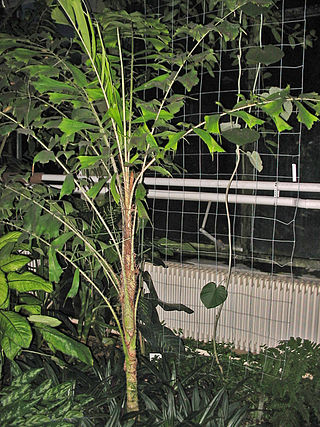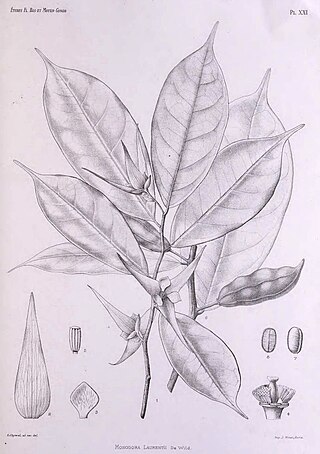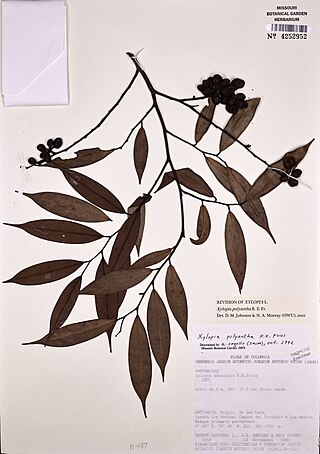
Aiphanes is a genus of spiny palms which is native to tropical regions of South and Central America and the Caribbean. There are about 26 species in the genus, ranging in size from understorey shrubs with subterranean stems to subcanopy trees as tall as 20 metres (66 ft). Most have pinnately compound leaves ; one species has entire leaves. Stems, leaves and sometimes even the fruit are covered with spines. Plants flower repeatedly over the course of their lifespan and have separate male and female flowers, although these are borne together on the same inflorescence. Although records of pollinators are limited, most species appear to be pollinated by insects. The fruit are eaten by several birds and mammals, including at least two species of amazon parrots.
Main Ridge is the main mountainous ridge on the island of Tobago, Trinidad and Tobago. It is a 29-kilometre (18 mi) chain of hills which runs from southwest to northeast between the Caribbean Sea and the Southern Tobago fault system and reaches a maximum height of 572 m (1,877 ft). The Main Ridge Forest Reserve, which was legally established in 1776, is one of the oldest protected areas in the world. It is a popular site for birdwatching and ecotourism. Main Ridge provides important habitat for native plants and animals, including several species endemic to Tobago.
Bactris campestris is a small spiny palm which grows in multi-stemmed clumps in savannas and low forests in northern South America from Colombia to the Guianas, Trinidad and Tobago, and northern Brazil.

Echinocereus reichenbachii is a perennial plant and shrub in the cactus family. The species is native to the Chihuahuan Desert and parts of northern Mexico and the southern United States, where they grow at elevations up to 1,500 meters (4,900 ft). This cactus earned the Royal Horticultural Society's Award of Garden Merit.
Podocarpus trinitensis is a species of conifer in the family Podocarpaceae. It is endemic to Trinidad and Tobago, where it has only been recorded from the island of Trinidad. It has been recorded from 13 distinct localities in Trinidad, including sites in the Central Range and in central and eastern areas of the Northern Range.
Pseudoxandra williamsii is a species of plant in the Annonaceae family. It is endemic to Peru. Robert Elias Fries, the Swedish botanist who first formally described the species using the basionym Cremastosperma williamsii, named it after Llewelyn W. Williams, the Welsh economic botanist, who collected the holotype specimen he examined.

Roupala is a Neotropical genus of woody shrubs and trees in the plant family Proteaceae. Its 34 species are generally found in forests from sea level to 4000 m altitude from Mexico to Argentina.
The endemic flora of Trinidad and Tobago includes a total of 59 species of vascular plants belonging to 34 plant families. This is less than 3% of the total vascular plant flora of Trinidad and Tobago. Thirty-nine of these species are endemic to Trinidad, 12 are Tobagonian endemics, and six are present on both islands.
Dicliptera aripoensis is a species of plant in the family Acanthaceae which is endemic to Trinidad and Tobago. The species is only known from the Heights of Aripo, in Trinidad's Northern Range. It is a branching shrub, 1–1.5 m tall with red flowers about 3 cm long.
Justicia flaviflora is a species of herbaceous plant in the family Acanthaceae. It was previously classified as Beloperone flaviflora. The species is endemic to the island of Trinidad in the Caribbean republic of Trinidad and Tobago where it is only known from near the peaks of mountains in the Northern Range. It is an erect herb with leaves up to 27 cm (11 in) long. It is suffering from habitat degradation and has become increasingly rare, being now rated as "critically endangered".
Justicia tobagensis is a species of plant in the family Acanthaceae which is endemic to Trinidad and Tobago. The species is only known from two areas in the Main Ridge of Tobago. It was first described as Drejerella tobagensis by German botanist Ignatz Urban in his Symbolae Antillanae, based on a collection made by Danish botanist Henrik von Eggers
Odontonema brevipes is a species of plant in the family Acanthaceae which is endemic to Trinidad and Tobago. The species is only known from four localities in the Main Ridge of Tobago. It was described by German botanist Ignatz Urban in his Symbolae Antillanae, based on collections made by Danish botanist Henrik von Eggers and English-born Trinidadian botanist Walter Elias Broadway.
Aristolochia boosii is a species of woody vine in the Aristolochiaceae plant family which is endemic to Trinidad and Tobago. Known only from a few locations in southern Trinidad, the species was first collected by Julius Boos in 1977. After determining that it was new to science, the species was described by Jacqueline Anne Panter in 1981 and named for its discoverer.
Roystonea princeps, commonly known as Morass cabbage palm or Morass royal palm, is a species of palm which is endemic to western Jamaica.

The environment of Trinidad and Tobago reflects the interaction between its biotic diversity, high population density, and industrialised economy.

Duguetia is a genus of trees and shrubs in the plant family Annonaceae with approximately 90 species in central and South America, and four species in west Africa.
Marthella is a genus of flowering plants in the Burmanniaceae, first described as a genus in 1903. It contains only one known species, Marthella trinitatis, endemic to the Island of Trinidad. It is considered critically endangered and only naturally appears in Northern Range Forest Reserve Section B. As a conservation measure, it is being cared for in the Heights of Aripo Village as a form of ex situ conservation.

Monodora laurentii is a species of plant in the family Annonaceae. It is native to the Democratic Republic of the Congo, Gabon, and the Republic of the Congo. Émile De Wildeman, the Belgian botanist who first formally described the species, named it after Marcel Laurent, the Belgian botanist who collected many plant specimens in the regions along the Congo River.

Pseudoxandra polyphleba is a species of plant in the family Annonaceae. It is native to Bolivia, Brazil, Colombia, French Guiana, Guyana, and Peru. Ludwig Diels, the German botanist who first formally described the species using the basionym Unonopsis polyphleba, named it after the distinctive veins in its leaves.

Xylopia polyantha is a species of plant in the Annonaceae family. It is native to Bolivia, Brazil, Colombia, Ecuador, and Peru. Robert Elias Fries, the botanist who first formally described the species, named it after its many flowers.








